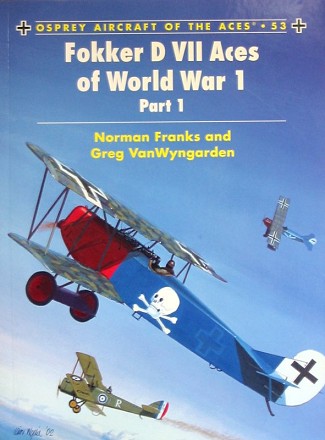|
BOOK: |
Fokker D.VII
aces of WWI, pt 1 |
|
BY: |
Norman Franks and
Greg Van Wyngarden |
|
PUBLISHER
/PRICE: |
Osprey
$19.95 |
|
REVIEW BY: |
Tom Cleaver |
|
NOTES: |
ISBN
1-84176-533-3 |
 It has been
frequently said of the Fokker D.VII that “it made the average pilot good
and the good pilot great.” In writing about the use of the airplane by
Jagdgeschwaders I, II, and III and the Bavarian Jagdgeschwader IV, this
fact is made very clear as one reads of German pilot after German pilot who
had a moderate score before flying the D.VII, whose success skyrocketed in
the desperate battles of the final four months of the First World War.
It has been
frequently said of the Fokker D.VII that “it made the average pilot good
and the good pilot great.” In writing about the use of the airplane by
Jagdgeschwaders I, II, and III and the Bavarian Jagdgeschwader IV, this
fact is made very clear as one reads of German pilot after German pilot who
had a moderate score before flying the D.VII, whose success skyrocketed in
the desperate battles of the final four months of the First World War.
What particularly interested me in this book was the carefully-researched
operational biographies of so many lesser-known aces I had not found good
material on previously. Thus, the book had the effect of actually expanding
my knowledge of the subject - something that doesn’t happen with every
aviation history book I come across.
Now that there are two very good 1/48 models of the Fokker D.VII that allow
modelers to not only make the D.VIIf which was the only sub-type ever
previously released, but also the early Fokker version, the Albatros
versions and the two Albatros (OAW) versions, the collection of interesting
color profiles of the D.VIIs flown by the aces whose biographies appear
here is a good place to start in coming up with possible markings. It is
obvious that Roden has used this material, and the profiles in Part 2 of
the history of the D.VII, in their choices for optional markings in their
series of D.VII kits. As I have said in other reviews, the markings
options for the Fokker D.VII are only exceeded by those for the
Messerschmitt Bf-109.
As is usual with the Osprey series, there are choices in the profiles that
some knowledgeable readers may disagree with, but the only one I found was
the choice of black-and-white rather than red-and-white for the upper wing
of Ernst Udet’s “candy-striper.” And even there, there is no definitive
choice to be made, given the fact only one photograph was ever taken of the
airplane and Udet himself blocks what little detail is available;
additionally, the argument is made that since Udet’s Dr.I is known to have
used black-and-white stripes, it would be logical the D.VII would follow
suit. There are some controversies that will only ever be solved by the
invention of inexpensive time travel, and this is one of them.
Overall, the book is well-written and obviously well-researched with good
use of quotes from original sources, two things that to me have always made
the Osprey series stand out.
For those who have finally entered the wonderful world of modeling aircraft
of the Great War, this book is an excellent resource on its own and a good
starting-off point for further research about the men willing to fly and
fight in their primitive-yet-complicated airplanes. Highly recommended.
October 2005
Thanks
to Osprey for the review copy -
www.ospreypublishing.com
If you would like your product reviewed fairly and quickly by a
site that averages around 300,00 visits a month, please contact
me or see other details in the Note to
Contributors.
 It has been
frequently said of the Fokker D.VII that “it made the average pilot good
and the good pilot great.” In writing about the use of the airplane by
Jagdgeschwaders I, II, and III and the Bavarian Jagdgeschwader IV, this
fact is made very clear as one reads of German pilot after German pilot who
had a moderate score before flying the D.VII, whose success skyrocketed in
the desperate battles of the final four months of the First World War.
It has been
frequently said of the Fokker D.VII that “it made the average pilot good
and the good pilot great.” In writing about the use of the airplane by
Jagdgeschwaders I, II, and III and the Bavarian Jagdgeschwader IV, this
fact is made very clear as one reads of German pilot after German pilot who
had a moderate score before flying the D.VII, whose success skyrocketed in
the desperate battles of the final four months of the First World War.